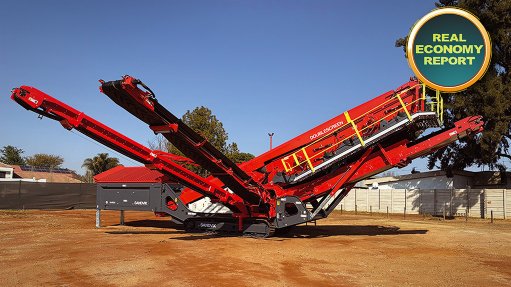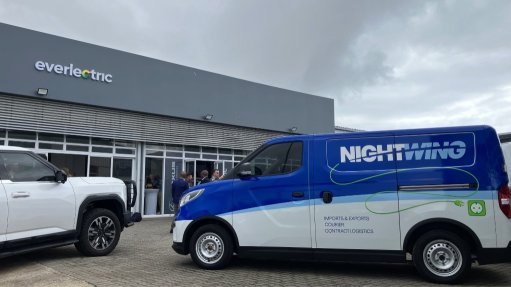Msikaba bridge construction slated for completion by end of 2024
Construction of the Msikaba cable-stayed bridge near Lusikisiki, in the Eastern Cape, should be complete in the last quarter of next year.
Work on the project, which forms part of the N2 Wild Coast Toll Road roll-out, started in earnest in 2019.
The bridge, which will span the 198-m-deep Msikaba river gorge, is being constructed by the CME joint venture (JV), a partnership between Concor and MECSA, both 100% black-owned Grade 9CE South African construction companies.
Advanced StageThe bridge’s four huge anchor blocks are now at an advanced stage of construction, with more than 50% of the concrete for the two 127-m-high pylons poured, and the complex deck construction phase of the project about to start.
The project had recorded three-million lost-time injury-free hours on October 21.
Msikaba project director, Concor’s Laurence Savage, regards the bridge as probably the most complex structure of its type ever to be built in Africa.
“At 580 m in length, it will be the longest cable-stayed bridge – in terms of main span – in Africa, and it will have the second-longest main span of any bridge on the continent.
“At 192 m above the floor of the gorge, it will also rank as one of the highest bridges in Africa, only exceeded by the Bloukrans bridge at 216 m, once it is completed.”
The bridge is being built from both the north and south banks of the gorge and comprises two identical halves, each spanning 290 m.
The halves will meet midpoint over the gorge.
Each half is supported by 17 pairs of cables attached to 127-m-high inverted Y-shaped concrete pylons, one on either side of the gorge.
The pylons are back-stayed into the anchor blocks by 34 pairs of cables – 17 on either side of the gorge.
With the anchor blocks approaching completion and the legs of the pylons – which make up the first 20 m of the pylon structures – already complete, the focus of the project going forward is on the construction of the circular pylon spires and the composite steel and concrete bridge deck.
The spires taper from a diameter of 6 m at the point where they start (the top of the inclined legs) to 4.5 m at their full height.
To construct them, the JV is using a custom-designed, four-level, 15-m-high climbing formwork system.
Both pylons are expected to be fully complete in September.
Construction of the bridge deck has to consider the significant winds that can sometimes occur at the site, gusting up to 80 km/h.
The first 24 m of the deck on either side of the gorge is a reinforced concrete ladder deck that is cast into the first steel deck segment, known as deck segment zero –DS0.
Because of crane access restrictions, DS0 will be slid laterally into place before reinforcement is installed and concreted.
The remaining segments, DS1 to DS17 on either side, will be installed using the free cantilevering method, with each segment being installed in sequence.
To place the deck segments in position, two gantries will be used, one on either side of the gorge.
These are large 160 t assemblies, each roughly the size of a tennis court in surface area.
They will launch the deck segments – which have an average weight of 84 t –out over the gorge and then rotate 90°, lower, align with and then connect them with the previous segments.
Closure at the midpoint of the deck is expected to be achieved in the second quarter of next year.
Considerable Cost“We have worked very hard – and at considerable cost – to ensure that the project has the full support of surrounding communities, and that the benefits stemming from construction are localised to the greatest extent possible,” adds Savage.
The CME JV has recruited about 70% of its workforce locally, and it has also identified and supported a host of local small businesses, about 40 in all, which have been appointed as subcontractors and suppliers.
Comments
Press Office
Announcements
What's On
Subscribe to improve your user experience...
Option 1 (equivalent of R125 a month):
Receive a weekly copy of Creamer Media's Engineering News & Mining Weekly magazine
(print copy for those in South Africa and e-magazine for those outside of South Africa)
Receive daily email newsletters
Access to full search results
Access archive of magazine back copies
Access to Projects in Progress
Access to ONE Research Report of your choice in PDF format
Option 2 (equivalent of R375 a month):
All benefits from Option 1
PLUS
Access to Creamer Media's Research Channel Africa for ALL Research Reports, in PDF format, on various industrial and mining sectors
including Electricity; Water; Energy Transition; Hydrogen; Roads, Rail and Ports; Coal; Gold; Platinum; Battery Metals; etc.
Already a subscriber?
Forgotten your password?
Receive weekly copy of Creamer Media's Engineering News & Mining Weekly magazine (print copy for those in South Africa and e-magazine for those outside of South Africa)
➕
Recieve daily email newsletters
➕
Access to full search results
➕
Access archive of magazine back copies
➕
Access to Projects in Progress
➕
Access to ONE Research Report of your choice in PDF format
RESEARCH CHANNEL AFRICA
R4500 (equivalent of R375 a month)
SUBSCRIBEAll benefits from Option 1
➕
Access to Creamer Media's Research Channel Africa for ALL Research Reports on various industrial and mining sectors, in PDF format, including on:
Electricity
➕
Water
➕
Energy Transition
➕
Hydrogen
➕
Roads, Rail and Ports
➕
Coal
➕
Gold
➕
Platinum
➕
Battery Metals
➕
etc.
Receive all benefits from Option 1 or Option 2 delivered to numerous people at your company
➕
Multiple User names and Passwords for simultaneous log-ins
➕
Intranet integration access to all in your organisation


















